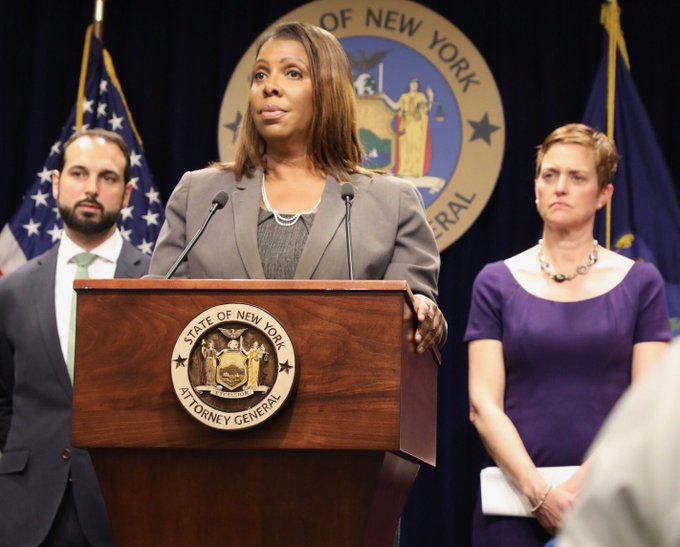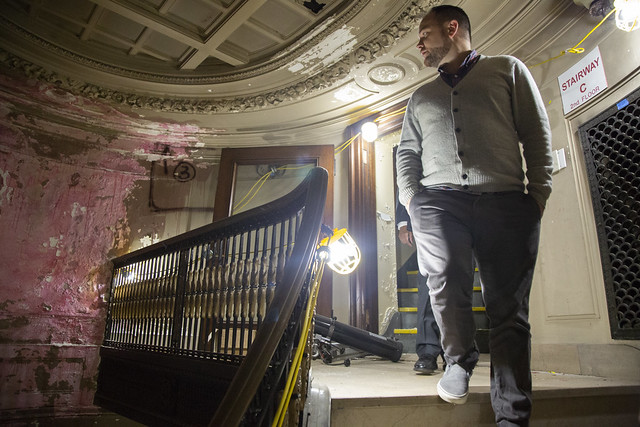We’re Transforming Public Sector Contracting

(photo: Michael Appleton/Mayoral Photography Office)
As the City of New York continues to work towards building the most efficient, most transparent, highest functioning government possible, the historically opaque and wasteful government contract procurement process is often overlooked, and for too long has been deemed too complicated to untangle.
But new technology has the capacity to make government procurement simpler, faster, and cheaper -- and it is happening in New York.
Of the city’s $92+ billion annual budget, over 20% -- approximately $19.3 billion -- is spent buying the necessary goods and services used to provide vital services to New Yorkers, maintain and improve the city’s infrastructure, and facilitate the government’s day-to-day operations via nearly 40,000 financial transactions. For any large organization, from governments to Fortune 500 companies, managing that kind of scale is a challenge, requiring dedicated people and state-of-the-art software that is up to the task of making procurement as efficient as possible.
At Ivalua we have spent the last two decades building our spend management software to maximize value for both private and public sector organizations along every step of the procurement process, and we’re in the midst of doing it for the City of New York.
Spend management technology enables procurement and supply chain leaders to more effectively manage how their money is being spent by:
-Identifying opportunities to reduce costs and drive efficiencies;
-Improving transparency in bidding to ensure competitive pricing;
-Speeding up the contracting process;
-Streamlining the purchasing process for procurement officers and suppliers to ensure invoices match contracts.
Leading private sector companies have long leveraged such technology to optimize their procurement processes, maximizing value, improving efficiency, mitigating risk, and ensuring transparency for shareholders. Unfortunately, the ability of governments to drive similar results has been greatly limited until now.
Despite their best intentions, strict regulations and complex, ever-evolving legislation have bound the hands of those charged with procuring the goods and services needed to run a government. For decades, city agency procurement teams have had to rely on paper-based processes or homegrown, subpar solutions, without the best-of-breed capabilities that drive real value in the private sector. This frustrates everyone, from taxpayers who just want a park built, to the companies selling the playground equipment.
For years, Ivalua has been helping the most proactive public sector leaders close this gap at all levels of government, including states such as Maryland, Arizona, and Ohio, Shared Services Canada, Paris’ airports, and now right here in the great City of New York. With a major office right here in Manhattan (one of 15 around the globe), we live here and rely on the same vital services.
For New York, we’re now implementing a complete suite to maximize the efficiency and transparency of city government.
The city planned its transformation over three phases spanning several years due to the massive complexity involved. The first phase focused on vendor management and deployed in 2017. A vendor registration process that used to require 12 pounds of paper per vendor and take most vendors 30 days has been fully digitized and cut to just a day.
Information that was previously siloed at dozens of agencies is now shared, improving transparency and efficiency, with input already provided by over 12,000 contractors, 24,000 members of their staffs, and 7,000 city agency staff. Contracts can now be registered more quickly with more timely, automated submission to the city Comptroller.
The second phase deployed more recently and focused on streamlining the purchasing process itself. The third phase will address the bid solicitation and invoicing processes to take taxpayer dollars further while improving payment timeliness and accuracy. It is in design mode, on schedule to be delivered in 2020.
All told, New York City has already significantly improved efficiency, transparency, and the ability to deliver better services more rapidly. While much work remains, the Mayor’s Office of Contract Services has taken an incredible step forward that will prove to be a model for cities across the country, and we are proud to be leading the way with them.
***
Dan Amzallag is CEO of Ivalua, Inc. On Twitter @ivalua.
***
Have an op-ed idea or submission for Gotham Gazette? Email This email address is being protected from spambots. You need JavaScript enabled to view it.
Attorney General James Should Sue to Dissolve the Trump Organization

NY AG Letitia James (photo: @NewYorkStateAG)
For a company of only a few dozen employees, the Trump Organization has accumulated an astonishing rap sheet of fraud, crime, and other corporate misconduct over the years. And since its owner came to occupy the Oval Office, the company has sunk to new depths as a vehicle for influence and corruption by supplicants from corporate lobbies and foreign governments.
Now that federal prosecutors have refused to pursue a clear case of felony campaign violations using the Trump Organization as the fraudulent financial vehicle, Trump’s Attorney General and the federal Department of Justice are giving the boss’ company a green light for similar campaign crimes in 2020.
But New York Attorney General Letitia James doesn’t answer to Trump, and she has a power unique in America: the power to investigate and potentially dissolve the Trump Organization. It’s time to use that power.
Under the state’s Business Corporation Law—the modern version of a long-standing legal procedure with a rich history tracing back to the medieval English “writ of quo warranto” —Attorney General James can file a lawsuit in state court to dissolve a corporation, such as the Trump Organization, that is incorporated in New York. The test is whether the company “has exceeded the authority conferred upon it by law,...or carried on, conducted or transacted its business in a persistently fraudulent or illegal manner, or by the abuse of its powers contrary to the public policy of the state has become liable to be dissolved.” (This is a cousin of the separate legal provision under which the New York Attorney General successfully sued to dissolve the Trump Foundation.)
This type of lawsuit to dissolve a corporation isn’t common, but it isn’t rare either. Right now, Attorney General James is in the middle of a dissolution case against a credit card equipment leasing company, and just last year her office won another dissolution order against a different company. It’s true that neither of those were companies owned by the president of the United States—but it’s all the more important that the president should not get more lenient treatment for fraud than other citizens get. If no one is above the law, New York state law should apply to presidents and non-presidents equally.
Consider, then, the Trump Organization. That’s the small nerve center, based in Manhattan’s Trump Tower, that oversees a sprawling empire of about 500 tightly-controlled Trump businesses and real estate developments. Some of those, like the Trump National Doral Miami golf course, were legitimate businesses before the Trump Organization bought them. Others, such as the no-longer-Trump SoHo in Manhattan, seem on paper like they might be legitimate, but due to the Trumps’ poor business skills, can only be profitable through extensive fraud.
Still others, such as the Mar-a-Lago resort and the Trump International Hotel in Washington, D.C., began as legitimate businesses, but have become festering swamps of corruption since Trump entered the White House. And a few, such as a Panama City development dubbed “Narco-a-Lago,” or the failed Trump Tower Baku in Azerbaijan, seem to have been conceived at the start as vehicles for money laundering and corruption.
The case against the Trump Organization, detailed in a series of letters that we and our colleagues sent to Attorney General James and her predecessors, is extensive. Keep in mind that Michael Cohen already pleaded guilty to a campaign finance felony directly implicating Trump himself and Trump Organization officials knowingly and willfully.
Some of the charges on the company’s rap sheet—fraud against customers and investors, illegal political contributions, bribery, and obstruction of justice—reflect corporate misconduct of a relatively familiar type, but at an eye-opening scale. Other charges—violating U.S. sanctions against Iran, and facilitating the most flagrant presidential violations of the Constitution’s foreign and domestic emoluments clauses as a business model—are more unusual and also more compromising of our national security. The overall picture is a company soaked in a culture of corruption and impunity.
Dissolving the Trump Organization doesn’t mean closing office buildings, hotels, or golf courses, or putting innocent people out of work. The law provides that the Attorney General can work with a court-appointed receiver to develop a plan to ensure that relevant businesses can continue to operate and pay their staff and vendors while dissolution is pending in court, and allow for successful operation afterwards under new ownership.
Will Attorney General James use her authority to hold this corrupt company accountable? She’s not afraid to tangle with Trump. When he accused her—the first woman and the first African-American to be elected New York attorney general—of just being Governor Cuomo’s “tool” for “harassing” Trump’s businesses, she kept her cool and responded, “No one is above the law, not even the President. P.S. My name is Letitia James.”
It’s a name that Trump—as well as Don Jr., Eric, Ivanka, and the assortment of corrupt “business associates” sweating in Trump Tower—had better learn. Because if enough New Yorkers make their voices heard, her signature may soon appear on a lawsuit to dissolve the Trump Organization.
***
Ron Fein is the Legal Director of Free Speech For People. Jed Shugerman is Professor of Law at Fordham University School of Law. On Twitter @RonFein & @JedShug.
***
Have an op-ed idea or submission for Gotham Gazette? Email This email address is being protected from spambots. You need JavaScript enabled to view it.
Improving Opportunity Zones to Truly Benefit Needy Communities in New York City

Speaker Johnson, the author, at a construction site (photo: John McCarten/City Council)
Opportunity Zones, which were part of the 2017 federal tax package, have the potential to improve low-income communities. But the way they are currently structured, they will only benefit neighborhoods already in the midst of building booms and gentrification.
Here is how they are supposed to work: Investors get tax breaks if they invest in businesses and property development in low-income communities. In New York City, investors are eligible to save on state and local taxes in addition to their federal taxes.
Unfortunately, in a city like New York that already has substantial incentive programs across the city and has enjoyed relative economic success in recent years, these new incentives could end up mostly going to projects that would have happened anyway.
Opportunity Zone neighborhoods like Long Island City, Downtown Brooklyn, and Gowanus are communities where private investment has already poured in, and seems poised to continue doing so even without the extra tax incentive - and as a result, they are expected to attract the majority of any Opportunity Zone investment that does happen. Our city does have neighborhoods that would benefit from the additional investment right now, but these aren’t them.
Displacement is a concern, too.
The expected concentration of investment in a small handful of already-affluent (and often rapidly-changing) communities, and in high-end real estate, could accelerate many of the elements of gentrification that we are already struggling to keep up with.
Fiscally, the program could be a huge loser for New Yorkers.
With investors looking for the optimal combinations of high-profit and low-risk investments, and no requirements that investments deliver any public benefit, capital is likely to flow toward large, low-risk companies and high-end residential, commercial, or hotel development. In other words, not the intended targets, and not the people or businesses who could use help from the government.
New York City taxpayers will bear a huge chunk of the cost. The city’s loss of tax revenue shares from Opportunity Zone tax breaks at the federal, state, and local levels could amount to $715 million just over the next five years – and much more over the following decades as investors continue to cash in on tax-free capital gains.
In New York, officials must make sure these Opportunity Zones help the right targets in the most vulnerable communities.
First, lawmakers in Albany must add localized criteria to the incentives. In order to be eligible for state- or city-level Opportunity Zone breaks, I am proposing that a project must be receiving substantial state or city government discretionary assistance, such as direct subsidy, land acquisition, or subsidized loans. This would help because local government agencies consider public benefit as a factor in dispensing discretionary assistance, so this change would enshrine a requirement of at least some benefit for local communities.
Second, we need to right-size other, complementary subsidies for projects. State and city agencies should consider Opportunity Zone equity sources as part of their due diligence process and allocation calculations when disbursing subsidy. This could prevent the unnecessary over-subsidizing of projects receiving both government assistance and Opportunity Zone tax breaks.
Third, we need robust monitoring at all levels. Federally, and at the state level, administrators must mandate transparency, monitor compliance, and evaluate results to ensure that Opportunity Zone incentives are used appropriately, fairly, and to the benefit of the public.
In cities like New York, this program could be a windfall for wealthy investors to little community benefit. But with action from state legislators, there is still a chance to salvage at least some benefit for New Yorkers who actually need it.
***
Corey Johnson is the Speaker of the New York City Council. On Twitter @NYCSpeakerCoJo.
***
Have an op-ed idea or submission for Gotham Gazette? Email This email address is being protected from spambots. You need JavaScript enabled to view it.




